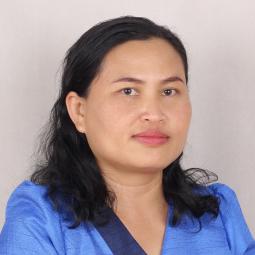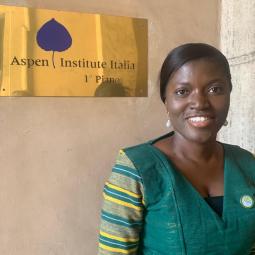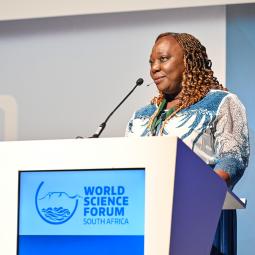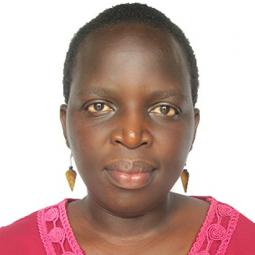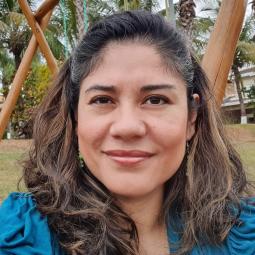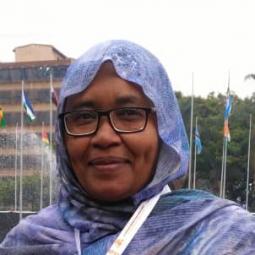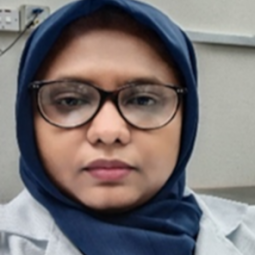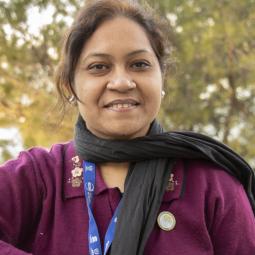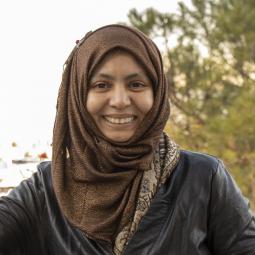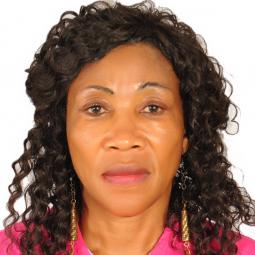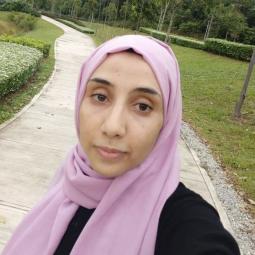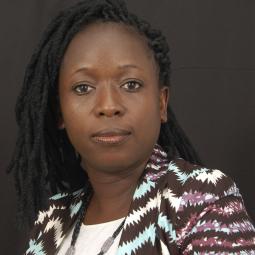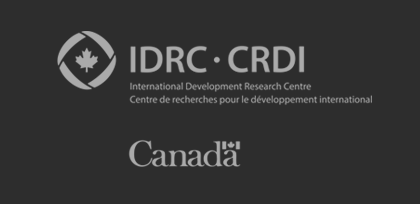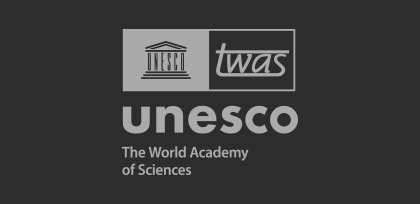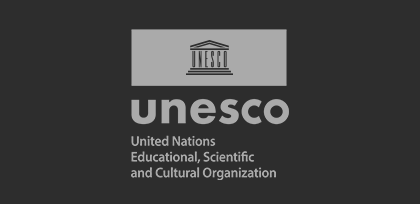Introducing the 2023 OWSD Early Career Fellows
December 08, 2023
Twenty-six women from the developing world have been awarded OWSD Early Career Fellowships, supporting them to establish international-level research centers at institutions across the Global South.
OWSD is pleased to announce the 26 women who have been granted the 2023 Early Career Fellowship. These scientists will receive up to USD 50,000 to lead research projects and establish research groups at their home institutions in 16 countries in the developing world, to maintain an international standard of research and attract scholars from all over the world to collaborate. Funding for the fellowships is generously provided by Canada's International Development Research Centre (IDRC).
During the 3-year fellowship, fellows will receive specific training to build on their leadership and management skills and develop connections with a variety of public and private sector partners to potentially convert their research into marketable products or guarantee its impact on a broader scale. By improving their communication and outreach skills, fellows will also learn to effectively present their research to various audiences, thus attracting new collaborators and potential funders to ensure the sustainability of the research project.
This year's fellows are working on subjects ranging from the recycling of household biowaste into biogas, to development of fortified snacks to address iron and folic acid deficiency in pregnant women, to patenting new strains of bacteria to block arbovirus transmission in Africa. They also include the first fellows awarded in Eswatini and El Salvador.
Meet all the 2023 Early Career fellows below.
Early Career Fellows

Sheila Biloh Agha
Her research project will identify a native (African) strain of Wolbachia, an environmentally friendly bacterium with arbovirus transmission-blocking potential, and make a patented version of the strain available across sub-Saharan Africa (SSA) for arbovirus control. In the last decade, the transmission of high-profile arboviruses like dengue, chikungunya, and yellow fever has increased in SSA, and by 2050, the number of arbovirus cases may outnumber malaria cases in the region. Insecticide resistance is increasing among major vectors, and microbial-based interventions are an attractive biological solution to arboviral threats. One such intervention that has been successful in Indonesia involves infecting Aedes aegypti mosquitoes with Wolbachia (strain wMel) and releasing them into the environment; the mosquitoes, which become resistant to arbovirus infection, replace arbovirus-susceptible wild-type populations. However, this same strain of Wolbachia may not suit SSA due to differences in Ae. aegypti genetics and climatic factors existing at continental scales. This project will evaluate a new Wolbachia strain for its ability to block arbovirus transmission in the different Ae. aegypti subspecies in Kenya, patent it and make it available across SSA for arbovirus control.

Paola Andrea Alvizuri Tintaya
Her research project will develop an ultrafiltration membrane from recycled residual polymers to remove heavy metals from Bolivia's Milluni lake, which supplies water to several important cities. Membrane filtering is increasingly used in environmental protection, especially for drinking water production, however the processes are still expensive and have a high environmental impact, limiting their wide application. The project will use a technique called Micellar Enhanced Ultrafiltration (MEUF) to create a more cost effective process. By utilizing recycled polymers, the project has a double impact by giving added value and extending the useful life of what are normally waste products.

Sunanda Baidya
Her project will explore the expression and role of the toll-like receptor TLR4, and how TLR4 correlates with tumor development, immune escape and chemoresistance in Head and neck squamous cell carcinoma (HNSCC). There are 800,000 new cases and 400,000 deaths from HNSCC every year worldwide, with an overall 5-year survival rate of <50% despite remarkable advances in therapy. Inflammation is a driver of tumor development and an essential signaling mechanism of it activates the TLR family involved in the recognition of microbes and cellular damage. How TLR4 participates in HNSCC tumorigenesis is not yet well understood; there are indications that it has a role in cancer progression in prostate, colon, & gastrointestinal cancers; but activation of TLR4 can also result in induction of anti-tumor immunity. The project will investigate the pattern of TLR4 expression in HNSCC and determine the pathophysiological significance of TLR4 in suppression of the immune surveillance mechanism and chemoresistance.
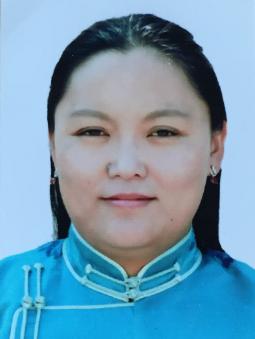
Buyanjargal Batchuluun
Her research project is a comprehensive study of insect biodiversity in Mongolia's Altai Preserve in the Altai mountain range, one of the last remaining unexplored areas of the world. Mountain mosaic habitats often serve as islands, home to high numbers of endemic and unique species. Little taxonomic research of any kind has been attempted in the preserve. The project will assess the general biodiversity of species in the region, as well as to uncover and identify the novel and rare insect species endemic to this habitat. Community workshops will also be organized to sensitize the local populace to the significance of these environments.

Abena Boakye
Her research project will investigate foodscapes and explore the food and nutrition potential of indigenous under-exploited crops (soul crops) in order to develp a nutrient composition database for such crops, and explore value-addition involving updating recipes of traditional foods in the malnourished Saboba district of Northern Ghana. Ghana has 3.6 million food-insecure and malnourished citizens; over 700000 more are expected in 2023. The brunt of the crisis is in Northern Ghana. The research will serve as a reference in guiding national and regional policy for community-specific nutrition and food security interventions.

Lydia Bunalema
Her research project will investigate the anti-plasmodial activity of medicinal plants used by Ugandan communities, as well as their potential to enhance the effectiveness of artemisinin treatment . Globally, there were an estimated 241 million malaria cases in 2020 in 85 malaria endemic countries, increasing from 227 million in 2019, with most of this increase coming from African countries. While treatment regimens containing the drug artemesinin remain the mainstay of malaria treatment across most parts of the world, recent trends show emerging resistance to artemisinins. This resistance is likely to worsen the effects of malaria in the population yet there are scarce chemical in the pipeline. The project will screen medicinal plants used in communities to treat malaria for their in-vitro antiplasmodial activity, and test plant extracts with the highest antiplasmodial activity for their inhibitory effect on enzymes involved in the breakdown of artemisinin.

Jayangika Niroshani Dahanayake
Her research project will identify novel derivatives of curcumin as potential anti-Alzheimer agents, and develop a nanocarrier drug delivery system for the effective delivery of these derivatives. Alzheimer’s disease (AD) is the most common cause of dementia among older adults and there are only a limited number of drugs available for treatment of AD. Most of these can only treat the symptoms, and are associated with side effects. Curcumin, a natural chemical produced by plants of the Curcuma longa species and the primary bioactive compound in turmeric, has been shown to improve cognitive function in AD patients; however it it has low bioavailability and is unstable in most body fluids. The project will study newly synthesized curcumin derivatives for their neuroprotective capabilities, as well as utilize nanoparticles to develop a targeted drug delivery system that can help them overcome the blood-brain barrier.
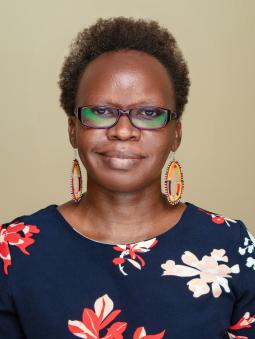
Jackie Epila
Her research project will test the potential to use a drought-tolerant native leafy vegetable species, Asystasia gangetica (Nees) Ensermu subsp. micrantha, to alleviate food insecurity in the Lango subregion of northern Uganda. A large majority of Ugandans (85%) rely on rainfed agriculture and are thus vulnerable to climate-change-induced drought stress on food security. Asystasia gangetica (Nees) Ensermu subsp. micrantha is an orphan crop, indigenous crops that are typically grown as subsistence crops by smallholder farmers and are little-known internationally. These crops can grow under harsh conditions and provide dry-season food with minimal farmer input. Despite this, they remain unexploited in northern Uganda, branded as "poor man’s food", and are dwindling due to erosion of indigenous knowledge, war, habitat loss, erratic rainfall patterns disrupting traditional socio-economic activities, limited arable land, and other factors. This project will seek to conserve the species and promote its use as a food crop by studying the potential for hydroponic production of the plant through seeds and stem cuttings in heightened drought- and flood-stress scenarios, as well as determine its nutritional composition and optimum cooking conditions and recipes.
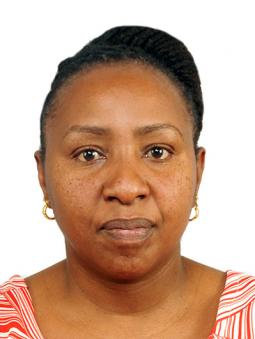
Esther Gwae Kimaro
Her research project will develop a plant-based pesticide for the control of tick borne diseases in livestock in Tanzania. Tick-borne diseases (TBDs) cause huge economic losses to the livestock industry annually. They cause low milk production in cattle, low quality of skins and hides, and high cattle mortality. Over USD 364 million is spent every year in Tanzania for TBD treatment, vaccination, and chemical pesticide application. Chemical pesticide application accountings for more than a quarter of these costs, and also contributes to increasing pesticide resistance among ticks as well as public health risks to farmers. This project will produce an affordable, effective, and non-toxic plant-based pesticide (acaricide) for tick control from a native wild bushy tree, Commiphora swynertonii, that has been seen to have acaricidal (anti-tick) properties, to help reduce the burden of tick infestations and tick-borne diseases in livestock.
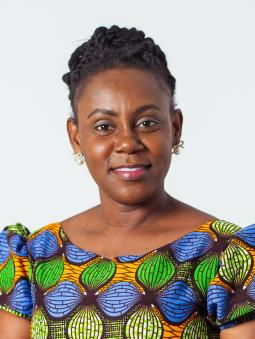
Bennetta Koomson
Her research project will devise a method to manufacture new cupels - receptacles used in mining to separate metals such as gold and silver from lead - using the residue of spent cupels after lead removal. Ghana is one of the world's leading gold producers and exporters, and the highest gold producer in Africa. Cupellation is a key stage in the gold mining process and generates huge tonnes of cupel waste annually. Spent cupels from mines and assay labs contain 37% lead on average, which is harmful to human health. While processes exist to remove lead from spent cupels, these processes ordinarily do not attempt to utilize the residue as engineering materials. This project will develop an optimized AI-controlled process to efficiently leach out the lead in the cupel waste, thereby rendering it non-toxic, and then to regenerate the lead in leachates for use in the metallurgical industry. The residue of the leaching process will then be supplemented with quicklime (calcium oxide, CaO) from local sources to produce fresh cupels for use by assay laboratories and gold refineries. Thus, this work will develop a circular economy for cupels and ensure efficient use of resources while protecting the environment from lead pollution.
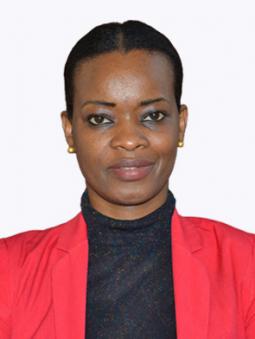
Judith Leo
Her research project will develop a quick, cost-effective bedside tool using AI and embedded systems for quick and precise detection of non-functional oxytocin, in order to prevent the occurrence of postpartum hemorrhage (PPH) in women following childbirth. Approximately 303,000 women and adolescent girls die every year due to complications of pregnancy and childbirth, with 99% of these deaths occurring in sub-Saharan Africa. PPH after childbirth is the leading cause of maternal death, accounting for 27% of all maternal death worldwide and approximately 30% to 50% of maternal deaths in sub-Saharan Africa. The World Health Organization recommends injection with oxytocin immediately after birth as an effective means of preventing PPH. While oxytocin is affordable in most of sub-Saharan Africa, it must be kept at 2-8 degrees Centigrade and is often not stable in normal working environments, particularly at lower-resourced health facilities where many deliveries take place. There is no currently available device to detect the condition of oxytocin in sub-Saharan Africa and Africa at large. The bio-digital tool developed under this project will use AI and embedded systems technologies to detect the functionality or non-functionality of oxytocin in real clinical settings.
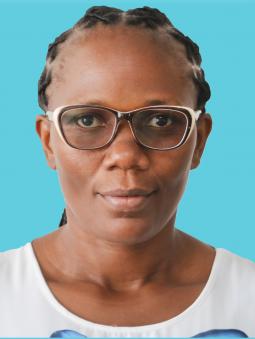
Elina Maseta
Her research project will develop a fortified mango-based snack in order to address the increase consumption of iron and folic acid among pregnant women in Tanzania. Micronutrient deficiencies are still highly prevalent in Tanzania and throughout the developing world. Pregnant women are often deficient in iron and folic acid (IFA), impairing the health of the mothers as well as their unborn children. The use of IFA supplements in the form of tablets has made some improvements in reducing anaemia among pregnant women, however compliance is low due to perceived side effects, unpleasant taste, and other factors. This project proposes a food-based strategy in order to improve compliance. A fortified fruit bar snack based on mango will be given to pregnant women while their haemoglobin levels are monitored. It is hoped that the snack will be more acceptable to the women than tablet-based supplements, as well as being a cheap and sustainable IFA delivery method.

Vuyiswa Mkhabela
Her research project will design and develop a hydrogel from the natural polymer chitosan, cross-linked with aloe, to be used for the accelerated healing of chronic wounds. Increasing costs of health care and the continued threat of chronic illnesses make chronic wounds a substantial clinical, social, and economic challenge. Specialized wound dressings or surgically-performed skin grafts are expensive for patients in the developing world. Hydrogels are good candidates as alternatives for wound dressings as they are able to form a barrier from pathogens and they help promote the body’s wound healing response. This project will utilize locally available aloe species, abundant medicinal plants that have been used in Eswatini for many years for their immune-stimulating and wound-healing properties, to develop a hydrogel with an improved healing rate and lesser side effects.
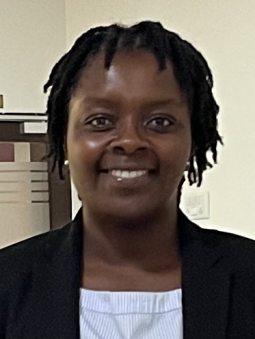
Angela Gerald Mkindi
Her research project will enhance access and availability of naturally pesticidal plant species and develop a formulation for sustainable pest management. Using pesticidal plants as an alternative pest management method has gained traction over the last decades as the negative impacts of synthetic chemical pesticides have become known; however their use has not been optimized due to low availability, high labour demand in processing, and little research on pesticidal chemistry and effective formulation. Understanding and documenting pesticidal plants’ chemical profiles is a prerequisite for effective research and successful formulations of botanical pesticides. This study will evaluate and document the chemical status of pesticidal plants found in northern Tanzania as well as evaluate the efficacy of innovative formulations for pest and disease management.

Marthe Montcho
Her research project will investigate tannin-rich forages suitable for mitigating methane production while improving dairy cattle performance in Benin. One of the challenges emerging from an increasing number of livestock is the resulting increase in the production of greenhouse gases, including carbon dioxide, methane, and nitrous oxide. The contribution of livestock to global anthropogenic methane emissions is estimated as 24–33%, most of which is from enteric fermentation. Dietary manipulation is one promising approach to reducing methane emissions from forage-fed ruminants; feeds containing natural phytocompounds such as condensed and hydrolysable tannins reduce enteric methane emissions and urinary nitrogen excretion. Better feed utilization efficiency also accelerates animal production and lowers farmers’ costs. Despite the high diversity of tannin-rich forage species in Benin, there are no studies addressing the use of tannins as methane reduction strategies. This research aims to provide dairy farmers with new innovative feeding practices that are both methane-reducing and efficient.
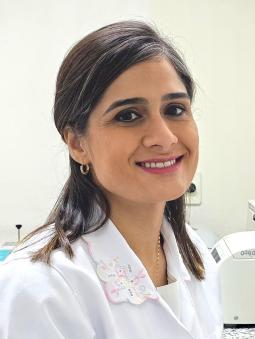
Juliana Moura Mendes Arrua
Her research project will develop new antifungal agents and combinations that can effectively combat emerging and neglected fungal pathogens. Fungal infections are an understudied global public health concern. Treatment options are limited and in many settings are expensive and toxic. In addition, the rapid emergence of resistance to antifungal drugs in recent years is an emerging health threat. This study will characterize the fungi considered priority according to WHO - Aspergillus, Fusarium, and Sporothrix - and evaluate the antifungal effect of natural products and synthetic compounds and their possible mechanisms of action, including changes in the proteome of the fungal isolates susceptible to the drug under study. The results generated will constitute a basis for the design of new antifungal treatment strategies, with special attention to sporotrichosis.

Esther Mwende Muindi
Her research project will investigate the existing soil acidity in the Kenyan highlands region and its sustainable management. Healthy soils uphold landscape resilience and regulate Earth’s climate while ensuring plant nutrition, agricultural productivity and food security; however these benefits are not achieved in many ecosystems due to either land degradation or limited soils management knowledge. Though approximately 83% of Kenyan crop production takes place within the highlands, the region suffers from soil acidity that is associated with an approximately 69% decline in maize, the country's most important crop for food security. As a management effort, the government recently began issuing fertilizer recommendations; but there are few comprehensive findings on the scope and distribution of existing acidity to sufficiently inform much-needed site- and crop-specific recommendations. This study will map soil acidity, evaluate short- and long-term sustainable management approaches for maize, common bean and iris potato production, and build capacity among farmers and other stakeholders in soil acidity management. The findings are expected to contribute to Kenya's food security and livelihoods by informing policymakers, farmers, and the research community.

Christine Betty Nagawa
Her research project will develop reinforced construction bricks and pavers using recycled plastic and sawdust waste and plastic. Plastic disposal and management is a major challenge in Uganda, as non-biodegradable plastics pile up at landfills or end up in bodies of water, where they threaten aquatic life. Sawdust produced by the sawing of wood is also a waste product; while it may be used in the manufacturing of particle boards and pulp and in the poultry and agriculture industries, in Uganda only a small percentage is recycled, and burning of sawdust contributes to the release of greenhouse gases. At the same time, there is a need for affordable bricks and other construction materials as the country is rapidly urbanizing and most building materials are costly. This project will convert these waste products into low-cost and user-friendly building materials to make construction of houses more affordable to communities.

Ndeye Maty Ndiaye
Her research project will develop new and efficient electrodes for green energy storage using supercapacitors, based on the novel composite MXene carbon-vanadium oxynitride. Senegal suffers from a very non-diversified energy landscape with most electricity coming from diesel and gas. The country faces a chronic electricity production gap which has worsened due to growing demand for electricity, predicted to increase by 15% by 2050. As energy storage devices, supercapacitors have drawn wide interest from both research and industry experts for their high power density and low energy density. Their performance is mainly dependent on the electrode materials and the operating electrolytes. This project will use ionic liquids, electrolytes that have a larger electrochemical potential window than aqueous and organic electrolytes, together with the novel composite MXene carbon-vanadium oxynitride used as an electrode for its unique chemical and physical properties. The interaction between the electrode and the ionic liquids will improve the low energy density of the supercapacitors.

Adela Ngwewondo
Her research project will characterize parasite- and host-specific biomarkers in genital exudates (menstrual/postpartum blood, vaginal lavage) of schistosomiasis patients, allowing the development of a home-based, non-invasive, comfortable, and field-friendly dipstick test to diagnose low-threshold active infections for prompt interventions. Infections due to the Schistosoma parasite are a major cause of parasitic morbidity. The diagnosis of infection by Schistosoma hematobium, the urinary blood fluke, has been done mainly through detection of parasite eggs and/or blood in patients' urine; however, this parasite can find its way to the genital tract and cause an additional pathology called urogenital schistosomiasis - in women, female genital schistosomiasis (FGS) - whose diagnosis is difficult even for health care providers. An estimated 56 million women and girls suffer from FGS, nearly all in sub-Saharan Africa, and it has been identified as a leading HIV/AIDS cofactor in that region. This project will promote family social welfare and positively impact the livelihood of women and children in the affected communities.
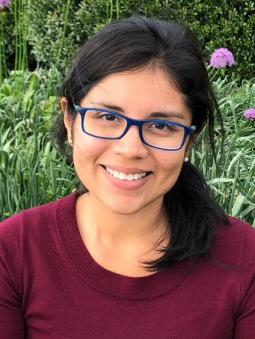
Violeta Martínez
Her research project aims to measure the occurrence of persistent pollutants in the Lempa River, the largest water reservoir in El Salvador, and in drinking water in the region. The presence of persistent pollutants in water sources is an issue of growing concern worldwide. This group of chemicals includes pesticides, plasticizers, and pharmaceuticals. In El Salvador, the extent to which these pollutants are present, their distribution, and the mechanisms that lead to their degradation are not fully understood. This study will establish a baseline measurement of these contaminants, identify light-driven processes that are responsible for their degradation (photodegradation mechanisms), and develop a pilot-scale prototype for removing the contaminants from drinking water.
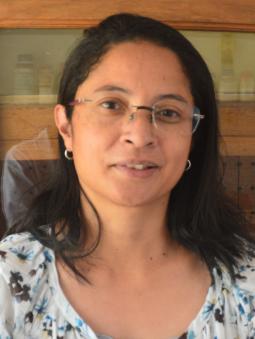
Mboahangy Ravoninjatovo
Her research project will develop inexpensive, nutritious, and easily-prepared food products from home processing methods and improved processing technology using legumes produced by local farmers in Madagascar. Malnutrition is a serious problem in Madagascar, where as many as 40% of children under five experience stunted growth. Madagascar has a large number of nutritious and edible plants including legumes. Legumes, when combined with cereals, provide an almost ideal level of dietary quality; but a high concentration of certain compounds in legumes, called anti-nutrients, affect the digestibility and bioavailability of nutrients and cause digestive discomfort. This project will devise new processing methods to reduce the concentration of these anti-nutrients, making legume-based food products more nutritious and digestible. It will also implement a manufacturing unit for artisanal products derived from legumes.

Tahsina Farah Sanam
This project will use machine learning to detect multi-stroke gestures and recognize Bangla Sign Languages in children with autism spectrum disorder using radio frequency (RF)-based wi-fi channel state information (CSI) signals. Autism Spectrum Disorders (ASD) can impact an individual's communication, social skills, or behavior, leading to repetitive motor movements or unusual behaviors. Communication and speech disorders are common among those diagnosed with ASD, and they may use augmentative and alternative communication (AAC) methods such as sign language, picture exchange communication, or flashcards. Despite a significant number of children in Bangladesh being affected by ASD, there is a limited number of healthcare professionals available to support them. Additionally, conventional ways of analyzing and evaluating the behavior and movements of children with ASD rely on intrusive and/or time-consuming methods such as wearable devices and manual observation of video footage. This project aims to improve the quality of life and social services for those with ASD by developing effective algorithms that utilize advanced techniques such as statistical learning, deep learning, and big data analytics. Additionally this system can establish a non-intrusive surveillance system to help clinicians diagnose ASD.

Induni Wathsala Siriwardane
Her research project will develop value-added nutraceutical products from Sri Lankan elderberry (Sambucus nigra) using nano-encapsulation techniques. Sri Lanka is a tropical country with rich plant biodiversity, where many plants and plant biomaterials have been historically exported or used as medical, nutraceutical and cosmeceutical ingredients, including tea, rubber, coconut, curcumin, and neem. Though many of these are very popular as market-ready products in international markets, Sri Lankan exports are still limited to the traditional exports due to lack of innovative products. This project will use nano-encapsulation to develop a market-ready nutraceutical product using the active ingredients of elderberry. The improvement of bioavailability of the elderberry active material will be tested during the study. The project will have several economic and social benefits to Sri Lanka, and the developed methodology and infrastructure will serve as a platform to implement similar techniques for other active ingredients from Sri Lankan origin, encouraging more competitive products to international markets.

Jesugnon Fifame Murielle Fety Tonouewa
Her research project will investigate and promote the use of bamboo and raffia palm as viable alternatives for construction and furniture applications in Benin. Forests face increasing pressure nationally and internationally as demand for wood resources increases, posing a significant threat to global ecosystems. Developing sustainable alternatives to wood is crucial. Fast-growing species such as bamboo and raffia palm, recognized for their remarkable carbon sequestration abilities, have a long-standing tradition of use in furniture and construction in Benin; but they are frequently harvested without any replanting efforts, and their processing methods remain rudimentary, transmitted as part of the cultural heritage. This research project seeks to address the problem of deforestation by developing innovative bamboo and raffia products through recombination or reconstitution methods, as well as by promoting bamboo and raffia palm as sustainable alternatives. In addition to protecting forests this will have the result of improving carbon sequestration, empowering communities, and preserving the cultural and social heritage of local populations.

Patience Tugume
This project will use various forms of bio-wastes from households and urban centres in Uganda as raw materials for production of biogas, as well as an ecofriendly biofertilizer and biopesticide. Large amounts of unconsumed food are often thrown away in homes and urban centres that could be converted into useful products that would supply energy, enhance agricultural productivity and reduce deforestation. This project will construct anaerobic biodigester tanks to process different kinds of bio-waste into biogas, a renewable energy source, and evaluate yields of biogas from different bio-wastes and combinations of bio-wastes. It will additionally produce a biofertilizer to enrich soil and a biopesticide to manage agricultural pests. The project will also equip households with the skills to biologically convert wastes into value-added products, training women and youth in biogas production and usage.

